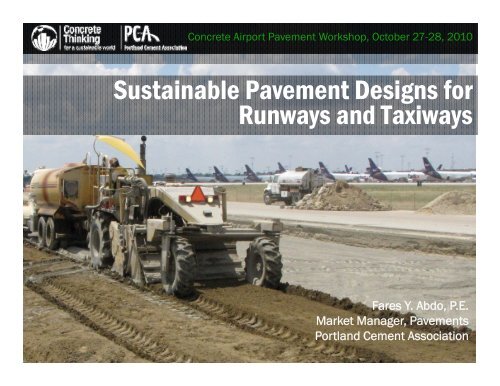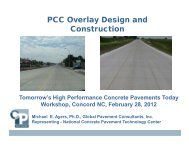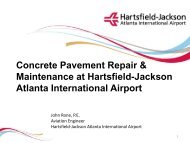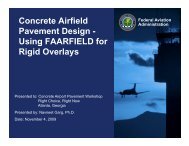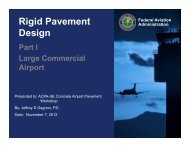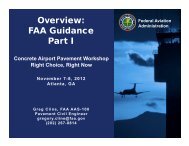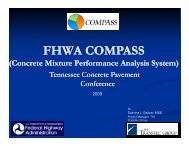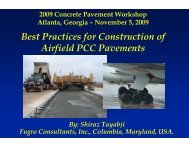Sustainable Pavement Designs for Runways and Taxiways
Sustainable Pavement Designs for Runways and Taxiways
Sustainable Pavement Designs for Runways and Taxiways
You also want an ePaper? Increase the reach of your titles
YUMPU automatically turns print PDFs into web optimized ePapers that Google loves.
Concrete Airport <strong>Pavement</strong> Workshop, October 27-28, 2010<br />
<strong>Sustainable</strong> <strong>Pavement</strong> <strong>Designs</strong> <strong>for</strong><br />
<strong>Runways</strong> <strong>and</strong> <strong>Taxiways</strong><br />
Fares Y. Abdo, P.E.<br />
Market Manager, <strong>Pavement</strong>s<br />
Portl<strong>and</strong> Cement Association
TM<br />
Presentation Outline<br />
• <strong>Pavement</strong>s <strong>and</strong><br />
Sustainability<br />
• Cement-Treated<br />
Bases<br />
• FAA Requirements<br />
• St<strong>and</strong>ard <strong>and</strong> Non-<br />
St<strong>and</strong>ard <strong>Pavement</strong><br />
Sections<br />
• Case Studies
TM<br />
What is sustainable development<br />
■ "Development that meets the needs of the<br />
present without compromising the ability<br />
of future generations to meet their own<br />
needs." World Commission on Environment <strong>and</strong><br />
Development’s Report Our Common Future (Ox<strong>for</strong>d University Press,<br />
1987).<br />
Paradigm shift –<br />
We have not inherited the world from our<br />
<strong>for</strong>efathers -- we have borrowed it from our<br />
children – ancient proverb
TM<br />
Sustainability<br />
(Thomas Olson-The Pittsburgh Tribune, 10/24/10)<br />
Sustainability is not an exact science<br />
• What Exactly is “Sustainability”<br />
• The concept of “sustainability” seems to be—as the<br />
word implies – here to stay<br />
• It's increasingly embedded in business, government<br />
<strong>and</strong> elsewhere
TM<br />
<strong>Sustainable</strong> Strategies<br />
• Longevity <strong>and</strong> Lifecycle cle Cost<br />
• Use of In-Situ Materials<br />
• Recycling <strong>and</strong> Waste Reduction<br />
• Optimal Material Utilization<br />
• Reduced Energy Use<br />
• Reduced Greenhouse Gas Emissions<br />
• Water Quality <strong>and</strong> Stormwater Runoff
TM<br />
ission i Critical Concrete <strong>Runways</strong><br />
ajority of Airports in U.S. were built during<br />
WII using concrete<br />
ittsburgh, Baltimore, Miami, Washington<br />
ational, <strong>and</strong> more are 60+ years old
TM<br />
avement Sustainability Rating systems<br />
<strong>Pavement</strong> sustainability <strong>and</strong> USGBC LEED<br />
rating system<br />
• <strong>Sustainable</strong> sites<br />
<strong>Pavement</strong> rating systems<br />
• Greenroads 1.0<br />
• GreenLITES<br />
• FHWA (under development)<br />
• FHWA (under development)<br />
• ASCE (under development)
TM<br />
e Future of <strong>Pavement</strong> Sustainability<br />
Greenroads<br />
State DOTs<br />
FHWA<br />
ASTM<br />
Rating<br />
System<br />
2<br />
Rating<br />
System<br />
1<br />
Rating<br />
System<br />
3<br />
ASCE/APWA/ACEC<br />
FAA; Others<br />
Agency<br />
Specifications<br />
Eventually, the influence of rating systems will diminish as
TM<br />
ement-Based <strong>Pavement</strong> Materials<br />
Roller-Compacted<br />
Concrete<br />
Pervious<br />
Concrete<br />
Conventional<br />
Concrete<br />
FAA<br />
Econocrete<br />
P-306<br />
AA<br />
Soil-Cement<br />
t-Treated<br />
t Cementubbase<br />
Treated<br />
Base<br />
01 &<br />
304 Flowable Fill<br />
ent Conte ent<br />
Cem<br />
Full-Depth<br />
Reclamation<br />
Cement-Modified<br />
Soil
TM<br />
finition<br />
ment-Treated Base – an intimate mixture of<br />
tive <strong>and</strong>/or manufactured aggregates with<br />
easured amounts of portl<strong>and</strong> cement (<strong>and</strong><br />
ssibly other cementitious materials) <strong>and</strong><br />
ter that hardens after compaction <strong>and</strong> curing<br />
<strong>for</strong>m a strong durable paving material
TM<br />
t materials can be treated with cement<br />
• Soils (s<strong>and</strong>, silt, clay)<br />
• Gravel<br />
• Shale<br />
• Crushed stone<br />
• Slag<br />
• Recycled HMA<br />
• Recycled concrete
TM<br />
hy Use CTB<br />
Economical pavement base<br />
Decreased base thickness compared to<br />
unbound aggregate base<br />
Structural properties maintained under varying<br />
moisture conditions<br />
High stiffness inhibits fatigue cracking <strong>and</strong><br />
rutting of asphalt surface<br />
<strong>Sustainable</strong> paving option
AA Base/Subbase Approved Materials<br />
TM
TM<br />
Purpose of Base/Subbase Courses<br />
(FAA AC 150/5320-6E)<br />
Flexible pavements<br />
• Principal structural components<br />
• Distribute the loads to the<br />
foundation<br />
Asphalt<br />
Base<br />
Subbase<br />
(Req. if CBR
TM<br />
mproved Per<strong>for</strong>mance in Rutting <strong>and</strong> Fatigue Cracking<br />
P<br />
P<br />
Unstabilized Granular Base<br />
Cement-Treated Base
TM<br />
Purpose of Base/Subbase Courses<br />
(FAA AC 150/5320-6E)<br />
Flexible pavements<br />
• Principal structural component<br />
• Distribute the loads to the<br />
foundation<br />
Rigid pavements<br />
• Provide uni<strong>for</strong>m stable support<br />
Asphalt<br />
Base<br />
Subbase<br />
(Req. if CBR
TM<br />
Materials <strong>for</strong> Base Course<br />
FAA AC 150/5320-6E Flexible <strong>Pavement</strong> Design<br />
m Base Course Max. Gross Load,<br />
lbs.<br />
8 Aggregate Base 60,000000<br />
9 Crushed Aggregate Base 100,000<br />
1 Lime Rock Base N/A<br />
9 Recycled Concrete Aggregate Base 100,000<br />
4 Cement Treated Base N/A<br />
6 Econocrete Subbase N/A<br />
1 Plant Mix Bituminous <strong>Pavement</strong>s N/A<br />
3 HMA Base N/A
TM<br />
Materials <strong>for</strong> Subbase Course<br />
FAA AC 150/5320-6E Flexible <strong>Pavement</strong> Design<br />
m Subbase Course 1 Frost Penetrating<br />
Subbase<br />
4 Subbase Course<br />
<br />
0 Caliche Base Course <br />
2 Shell Base Course <br />
3 S<strong>and</strong> Clay Base Course X<br />
1 Soil Cement Base Course X<br />
terials acceptable <strong>for</strong> base course can also be used <strong>for</strong> subbase course
TM<br />
Materials <strong>for</strong> Subbase Course<br />
FAA AC 150/5320-6E Rigid <strong>Pavement</strong> Design<br />
m Subbase Course Max. Gross Load,<br />
lbs.<br />
Subbase Course Requires quality 100,000<br />
aggregates or<br />
crushed<br />
concrete<br />
meeting same<br />
requirements<br />
Aggregate Base Course 100,000<br />
Crushed Aggregate Base Course 100,000<br />
Lime Rock Base Course 100,000<br />
Soil Cement Base Course 100,000<br />
Cement Treated Base Course<br />
Econocrete Subbase Course<br />
Plant Mix Bituminous <strong>Pavement</strong>s<br />
HMA Base Course<br />
N/A<br />
N/A<br />
N/A<br />
N/A
TM<br />
Engineering Properties of CTB<br />
Property 1 FAA P-301<br />
FAA P-304<br />
PCA CTB<br />
(Soil Cement)<br />
(CTB)<br />
Compressive N/A 2 Under PCC: 300 min.;<br />
gth, psi<br />
500 min.; 1000 max.<br />
Under HMA:<br />
750 min.; 1000 max.<br />
800 max.<br />
c Modulus, ksi 250 500 600-1000<br />
on’s Ratio 0.20 0.20 0.15<br />
efer to FAA AC 150/5320-6E <strong>for</strong> durability requirements<br />
AA recommendations <strong>for</strong> P-301 are based on wet-dry <strong>and</strong> freeze-thaw tests<br />
nd strength should increase with age
Mixing i Methods<br />
TM
TM<br />
ixing Methods<br />
■ Two methods<br />
■ Plant Mix<br />
■ Road Mix (in-place)
TM<br />
lant Mix<br />
FAA P-301<br />
FAA P-304<br />
Central<br />
Concrete<br />
Batch Plant
TM<br />
oad Mix<br />
In-situ or mixed in place materials<br />
Applicable <strong>for</strong><br />
FAA P-301 but<br />
ot P-304 (unless<br />
variance is<br />
granted)
oad Mix<br />
Spread cement<br />
Add water if<br />
necessary <strong>and</strong> mix<br />
Grade <strong>and</strong> compact<br />
Cure
oad Mix<br />
AA P-301<br />
ineers ordered a number of these large machines <strong>and</strong> has<br />
d on the use of Rototillers in the construction of the air field,<br />
pee, Mass., military airport, Brunswick Maine <strong>and</strong> airports<br />
hout the country.<br />
Troy Record, 1938 Troy Public Library, Library Source
TM<br />
oad Mix<br />
hen…
oad Mix<br />
nd now…<br />
Why can’t use this<br />
ethod to build FAA P-
TM<br />
nt vs. Road Mix Considerations<br />
Traffic loading/agency requirements<br />
• FAA P-304 spec includes plant mix only<br />
Quality of in-situ it materials<br />
Cost<br />
Haul distances: material sources, plant, jobsite<br />
Design thickness (one or multiple lifts)<br />
<strong>Sustainable</strong> considerations (Reduce, Reuse <strong>and</strong><br />
Recycle)
Applications<br />
TM
TM<br />
ere are stabilized materials used<br />
• Low volume roadways<br />
• Residential streets<br />
• State routes<br />
• Interstate highways<br />
• Airport runways <strong>and</strong> taxiways<br />
• Parking lots<br />
• Industrial storage facilities<br />
• Port facilities<br />
• Truck terminals<br />
In other words…<br />
any pavement structure!
ashington Dulles<br />
rport Runway 4, 2008<br />
18” PCC w/<br />
owelled transverse<br />
joints at 20 ft<br />
6” CTB, 6% cement<br />
12” Cement-<br />
Stabilized Subgrade,<br />
5% cement
TM<br />
ashington Dulles<br />
rport Runway 4<br />
Runway 4 completed in 2008<br />
Runway 12 was completed in<br />
2004
9” Cement-Treated 6” Cement-Treated<br />
Ex Hub at Alliance<br />
port, Fort Worth,<br />
1997<br />
Taxiway & Ramp<br />
Truck Terminal &<br />
14” PCC Container Storage<br />
9” CTB<br />
10” JRCP
TM<br />
Ex Hub at Alliance Airport, Fort Worth, TX<br />
0-yr design life<br />
ompleted in 1997<br />
30,000 yd 2<br />
ement-treated subgrade<br />
■ 7 % cement, 250 psi,<br />
reduced PI from 38 to less<br />
than 12<br />
ement –treated base<br />
■ 750 psi at 28 days
W SE Perimeter<br />
xiway, 2008<br />
irst perimeter taxiway in U.S.<br />
uilt <strong>for</strong> safety <strong>and</strong> to reduce<br />
ongestion delays<br />
18” CRCP<br />
12” CTB<br />
12” Lime-Treated
W SE Perimeter<br />
iway<br />
ompleted in 2008<br />
25,000 yd 2<br />
ata will be analyzed be<strong>for</strong>e<br />
uilding the remaining 3 loops
iedman Memorial<br />
rport, Hailey, Idaho<br />
Single asphalt runway<br />
serving the airport<br />
7,500 ft long runway.<br />
6,900 ft needed rehab<br />
Priority No. 1:<br />
Minimize runway<br />
shutdown time<br />
• Construction ti time
TM<br />
iedman Memorial Airport Runway, Hailey, Idaho<br />
Planned replacement<br />
airport in 10 years<br />
Three FAA approved<br />
methods considered but<br />
none could be done within<br />
30 days (fastest<br />
construction was estimated<br />
at 48 days)<br />
FAA approved owner’s<br />
Courtesy of T-O Engineers
TM<br />
dman Memorial Airport Runway, Hailey, Idaho<br />
FAA<br />
St<strong>and</strong>ard<br />
HMA<br />
4”<br />
Crushed -<br />
Stone Base<br />
6”<br />
FAA<br />
FAA<br />
Alternate 1 Alternate 2<br />
HMA<br />
4”<br />
Crushed-<br />
Stone Base<br />
14”<br />
HMA<br />
14.5”<br />
FDR<br />
Option<br />
HMA<br />
6”<br />
FDR<br />
12”<br />
Subbase<br />
15”
dman Memorial Airport Runway, Hailey, Idaho<br />
TM
TM<br />
iedman Memorial Airport Runway, Hailey, Idaho<br />
Constructed within contract time in 2007<br />
$1 million in construction o savings<br />
Reduced use of virgin materials from quarries<br />
Eliminated about 4,000 truck trips<br />
Reduced material disposal<br />
Reduced fuel use, air emissions, traffic<br />
congestion <strong>and</strong> damage to nearby roads
Dauphin Isl<strong>and</strong> Airport, Alabama<br />
TM
uphin Isl<strong>and</strong><br />
rport, Alabama
TM<br />
uphin Isl<strong>and</strong>, AL<br />
istress<br />
▪ Raveling<br />
▪ Severe<br />
cracking<br />
▪ Mild base<br />
failure
TM<br />
uphin Isl<strong>and</strong>, AL<br />
igh water<br />
able<br />
Courtesy of Volkert
TM<br />
uphin Isl<strong>and</strong> Runway Repair Options<br />
Remove <strong>and</strong> Replace<br />
• Mill existing Asphalt<br />
• Repair base<br />
• Place 4” asphalt<br />
wearing surface<br />
• Full Depth Reclamation<br />
• FDR = 7.5 75 Inches<br />
• Cement = 45 Lbs./<br />
SY S.Y.<br />
• Place 3.5” asphalt<br />
wearing surface
uphin Isl<strong>and</strong>,<br />
Courtesy of Volkert
TM<br />
auphin Isl<strong>and</strong>, AL<br />
Benefits of FDR Option<br />
• Reduced construction time<br />
• Higher pavement strength<br />
• 30% cost savings<br />
• Conservations of virgin materials <strong>and</strong> energy<br />
savings
TM<br />
Atlanta Airport Apron Project, 2010<br />
168,000 SY
TM<br />
nta Airport Apron Section<br />
FAA<br />
ndard<br />
As<br />
Constructed<br />
C (P-501)<br />
20” PCC (P-501)<br />
Courtesy of J A Long, Inc.<br />
conocrete<br />
P-306)<br />
il-Cement<br />
-301)<br />
9” Cement-Treaded<br />
Subgrade; 600 psi<br />
at 7 days
TM<br />
More In<strong>for</strong>mation<br />
www.cement.org/pavements


